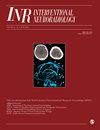重新考虑二甲亚砜在血管内栓塞:一个潜在的毒性依赖因素脑积水?
IF 2.1
4区 医学
Q4 CLINICAL NEUROLOGY
引用次数: 0
摘要
二甲基亚砜(DMSO)被广泛用作血管内栓塞手术的溶剂,但其潜在的神经毒性作用仍未得到充分研究。在这篇通信中,我们强调了新出现的证据表明,DMSO暴露可能通过涉及室管膜损伤和星形细胞凋亡的机制促进脑积水的发展。根据最近的实验结果,我们提出dmso诱导的神经炎症可能在栓塞后并发症中发挥作用。我们敦促研究界考虑脑积水作为一种可能的结果,尽管未经证实,暴露于DMSO,并将其纳入栓塞剂的长期安全性评估。本文章由计算机程序翻译,如有差异,请以英文原文为准。
Reconsidering dimethyl sulfoxide in endovascular embolization: A potential toxic-dependent contributor to hydrocephalus?
Dimethyl sulfoxide (DMSO) is widely used as a solvent in endovascular embolization procedures, yet its potential neurotoxic effects remain underexplored. In this correspondence, we highlight emerging evidence suggesting that DMSO exposure may contribute to the development of hydrocephalus through mechanisms involving ependymal damage and astrocyte apoptosis. Drawing on recent experimental findings, we propose that DMSO-induced neuroinflammation may play a role in post-embolization complications. We urge the research community to consider hydrocephalus as a possible, though unproven, outcome of DMSO exposure and to include it in long-term safety assessments of embolic agents.
求助全文
通过发布文献求助,成功后即可免费获取论文全文。
去求助
来源期刊

Interventional Neuroradiology
CLINICAL NEUROLOGY-RADIOLOGY, NUCLEAR MEDICINE & MEDICAL IMAGING
CiteScore
3.60
自引率
11.80%
发文量
192
审稿时长
6-12 weeks
期刊介绍:
Interventional Neuroradiology (INR) is a peer-reviewed clinical practice journal documenting the current state of interventional neuroradiology worldwide. INR publishes original clinical observations, descriptions of new techniques or procedures, case reports, and articles on the ethical and social aspects of related health care. Original research published in INR is related to the practice of interventional neuroradiology...
 求助内容:
求助内容: 应助结果提醒方式:
应助结果提醒方式:


